This post may contain affiliate links. Please read our disclosure policy.
A simple homemade Almond Yogurt made using just four ingredients and a super simple method- for a thick, creamy dairy-free yogurt.
This post has been a long time in the making; you wouldn’t believe how happy I am that it’s ready. This simple homemade almond milk yogurt is a great dairy-free yogurt recipe for any of you who are lactose intolerant, soy-free, and/or aren’t keen on coconut yogurt yet want to make homemade yogurt easily at home.
Just like my coconut yogurt though, this recipe took countless tried-and-failed attempts at getting it ‘just right’ to be able to make the perfect consistency of dairy-free yogurt. Unfortunately, when using ingredients like almond milk, that don’t (and won’t) thicken in the same way that dairy yogurts do, it can take quite a bit of experimentation to find methods that work well.
Luckily, I’ve found two methods that work particularly well, and I’m now very happily making my own almond yogurt – swapping it out with other homemade yogurt recipes that I know every few weeks. The best thing that this recipe only takes four ingredients and is a super simple method for foolproof almond yogurt every time.
A few notes about making this almond milk yogurt
1. Always use homemade almond milk:
I always intended this DIY to be entirely from scratch. However, curiosity led me to try to make almond milk yogurt from a variety of branded almond milk, and I never did find a version that I was happy with. Making homemade almond milk is so ridiculously simple anyway that it just makes sense to do it from scratch.
2. You’ll need a thickener/s:
Unfortunately, plant-based yogurt alternatives just don’t thicken up enough on their own with just the yogurt starter, unlike dairy-based products. I’ve tried numerous methods, and thickeners (believe me I’ve tried them all) and found two methods that worked best for me.
Method 1: A mixture of Agar agar & Arrowroot (my preferred consistency and method)
Method 2: Cornstarch & xanthan gum
Obviously, I know that many people turn to these homemade yogurt recipes to avoid all the nasty preservatives, gums, thickeners, and other additives in store-bought options so, for that reason, option two may not appeal to everyone. However, as it worked well for me, I thought I’d include the option.
Luckily, homemade still manages to keep this recipe much cleaner than commercial alternatives anyway, with no added sugars, and I’d never share a recipe with ingredients that I’m not 100% happy with consuming myself.
A note about Xanthan Gum
With the above being said, I thought I’d add a little section on the, perhaps controversial, xanthan gum in this recipe. Having tried and failed to make this yogurt with various thickeners, I decided to try xanthan gum and was very happy with the results.
I know that there is some general controversy around gums in general. However, with the research I’ve been able to do, I’m happy to include this in my diet minimally. If you want to read an evidence-based article on xanthan gum, its benefits, side effects, and more than you can on Healthline.
Method 2 was actually the first method I’d tried that genuinely worked well. However, for those that don’t want to use the gum then have no fear because method 1, using arrowroot and agar-agar is something I tested next and, if anything, the results are even better!
How To Make Almond Milk Yogurt
Needed
- raw almonds, filtered water (to make the almond milk)
- yogurt starter
- agar agar and arrowroot – to thicken the yogurt (or alternatively, cornstarch and xanthan gum)
You will also need a food thermometer.
The Steps
Step 1: First, sterilize your tools
Before you begin making the almond yogurt, sterilize all your tools. This includes the pot and bowl for the milk, the glass jar (or small jars) to store the yogurt, and the spatula and/or spoon you will be using.
Also, make sure you use wooden or silicone utensils. Metal spoons can cause a reaction with the warm milk, and it won’t turn into yogurt. To sterilize the tools, you can wash them with hot soapy water and then put them in the oven (no plastic parts) for 10 minutes at 160ºC.
Step 2: Make the Almond milk
Next, make fresh almond milk by blending the almonds with fresh water. I describe in detail how to make almond milk in this blogpost. However, this usually takes between 1-2 minutes to blend into rich, creamy almond milk thoroughly.
Note* Don’t throw away the leftover pulp – you can add it to smoothies or cereals. I give a lot more ideas here.
Step 3: Prepare the Almond Milk Yogurt
Pour the almond milk into a saucepan. Mix the arrowroot and agar-agar with a bit of cold almond milk and stir thoroughly to dissolve Add the mixture to the saucepan.
Heat on a low-medium heat until the milk reaches about 85ºC/185ºF. Stir occasionally, so the milk doesn’t stick to the bottom of the pot.
Depending on the exact temperature of your stove, heating the milk can take up to 30-40 minutes as this process needs to happen slowly at low-medium heat.
Once the temperature reaches 85ºC/185ºF, switch off the heat. If you don’t have a thermometer, switch off the heat before the milk starts boiling (right about when the simmering small bubbles start changing into bigger ones).
Set aside and leave the milk to cool down to about 45ºC/113ºF. This can take another 30-40 minutes.
If you don’t have a thermometer, you can dip your pinkie (clean!) in the warm milk and try to keep it there for 7-10 seconds before it starts to hurt. Be careful with this and touch the mixture lightly before plunging your finger into it, so you don’t get burnt.
The temperature needs to lower to about 45ºC/113ºF so that the heat doesn’t kill the yogurt starter.
Once the milk has cooled down, add your starter of choice and stir gently.
If using a powder starter, dissolve it with a bit of milk to create a ‘slurry’ then pour in the pot.
Sieve the mixture to remove any lumps and possible bits of the almonds. Pour in your desired sterilized jar(s). I like to pour individual portions into small pots to grab and go whenever I want.
Step 4: Incubate The Yogurt
Place the glass jar/s in a warm environment to “incubate” overnight. I wrapped mine in a warm blanket and left to intubate for 12 hours. The longer it ferments, the tangier the yogurt will taste.
After the incubation period, refrigerate for another 6 hours.
If you want the yogurt very thick and sour, you can incubate it for up to 24 hours. Then move it to the refrigerator.
Enjoy! Keep in the fridge for 4-5 days.
Flavoring options
It’s best to only flavor the amount of yogurt you are planning on consuming right away. This is another reason I love to store them in individual jars. However, here are some options to flavor your yogurt.
- You can add jams or pureed fresh fruit to the yogurt just before eating
- You can also add some nut butter or even homemade Nutella.
- If you prefer plain yogurt, you can drizzle some maple syrup or other natural sweetener.
- Another option is to add vanilla bean seeds.
You can then use this yogurt for various recipes including these Rainbow Ice Lollies, Healthy Yogurt Bark Recipe, or even these Healthy Yogurt Granola Cups.
If you have any questions, leave a comment below Also, I love seeing your recreations so feel free to tag me on Instagram @AlphaFoodie. Let me know what your favorite way of eating this yogurt is.

Homemade Dairy-free Almond Yogurt
Ingredients
- 1.5 cups of almonds
- 4 cups of water
- 1 packet powder yogurt starter 0.18 oz/5 g
Thickener
- Method 1: 1/2 Tbsp arrowroot powder & 1/2 Tbsp agar agar
- Method 2: 1/2 Tbsp corn starch & 1/2 tsp xanthan gum
Instructions
Step 1: Sterilize tools
- Sterilize all tools you will use and don’t use metal spoons/spatula as they can cause a reaction with the warm milk, and it won't turn into yogurt. To sterilize the tools, wash them with hot soapy water and then put them in the oven (no plastic parts) for 10 minutes at 160ºC/325ºF to fully dry.
Step 2: Make the Almond milk
- Make fresh almond milk by blending the almonds with fresh water. I describe in detail how to make your own almond milk in this blogpost. However, this usually takes between 1-2 minutes to thoroughly blend into rich, creamy almond milk.*
Step 3: Prepare the Almond Milk Yogurt
- Pour the almond milk into a saucepan. Mix the arrowroot and agar agar (or cornstarch and xanthan gum) with a bit of cold almond milk and stir thoroughly to make sure they are dissolved into a slurry. Add the mixture to the saucepan.
- Heat on a low-medium heat until the milk reaches about 85ºC/185ºF. Stir occasionally, so the milk doesn't stick to the bottom of the pot.
- Depending on the exact temperature of your stove, heating the milk can take up to 30-40 minutes as this process needs to happen slowly at low-medium heat.
- Once the temperature reaches 85ºC/185F, switch off the heat. If you don't have a thermometer, switch off the heat before the milk starts boiling (right about when the simmering small bubbles start changing into bigger ones).
- Set aside and leave the milk to cool down to about 45ºC/113ºF. This can take another 30-40 minutes.
- If you don't have a thermometer, you can dip your pinkie (clean!) in the warm milk and try to keep it there for 7-10 seconds before it starts to hurt. Be careful with this and touch the mixture lightly before plunging your finger into it, so you don't get burnt.
The temperature needs to lower to about 45ºC/113ºF so that the heat doesn't kill the yogurt starter. - Once the milk has cooled down, add your starter of choice and stir gently.
If using a powder starter, first dissolve it with a bit of the milk to create a 'surry' and then pour in the pot. - Sieve the mixture to remove any lumps and possible bits of the almonds. Pour in your desired sterilized jar(s). I like to pour individual portions into small pots to grab and go whenever I want.
- Place the glass jar(s) in a warm environment (wrapped with a warm blanket) to "incubate" overnight (for best results - incubate for 12 hours). The longer it ferments, the tangier the yogurt will taste.
- After the incubation period, refrigerate for another 6 hours. If you want the yogurt very thick and sour, you can incubate it for up to 24 hours before moving it to the fridge. Enjoy! Keep in the fridge for 4-5 days.
Video
Notes
Nutrition
Nutrition information is automatically calculated, so should only be used as an approximation.

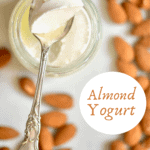
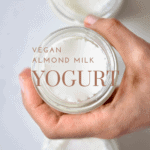
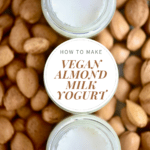

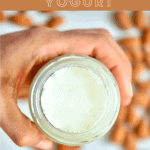


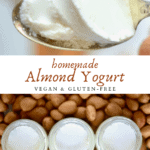
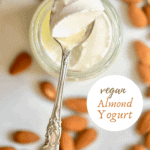
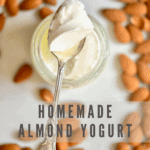
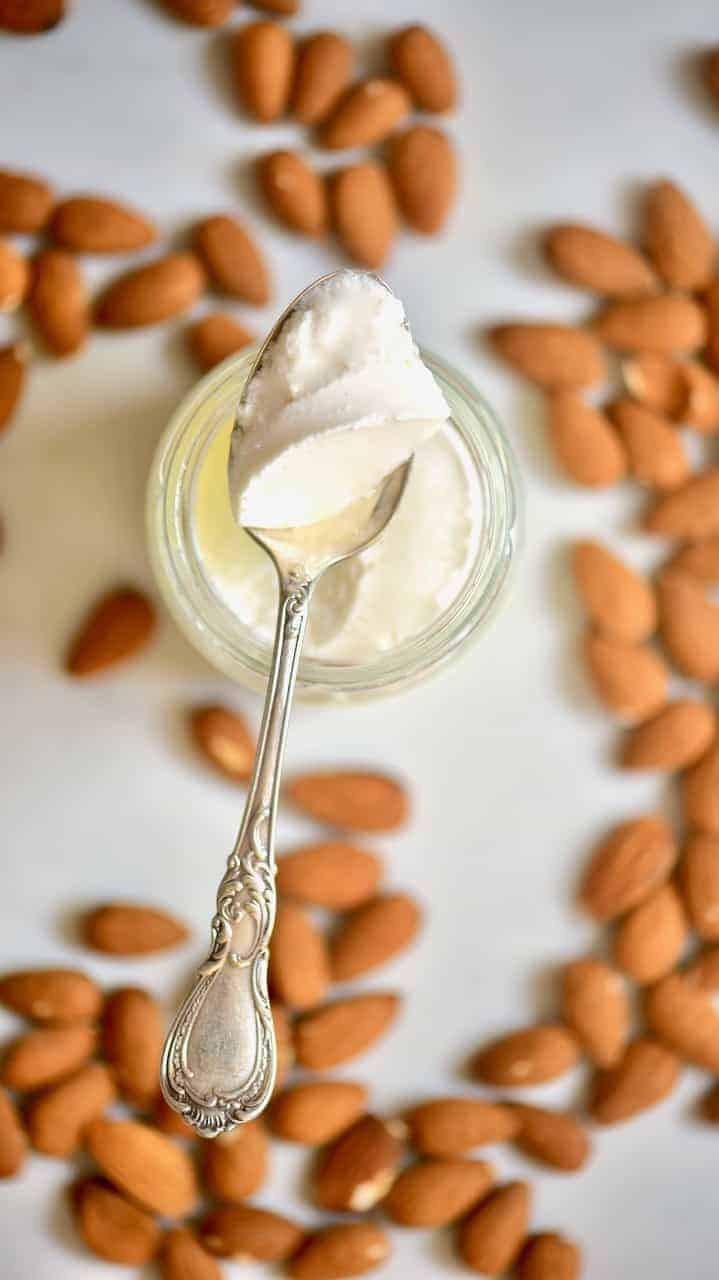
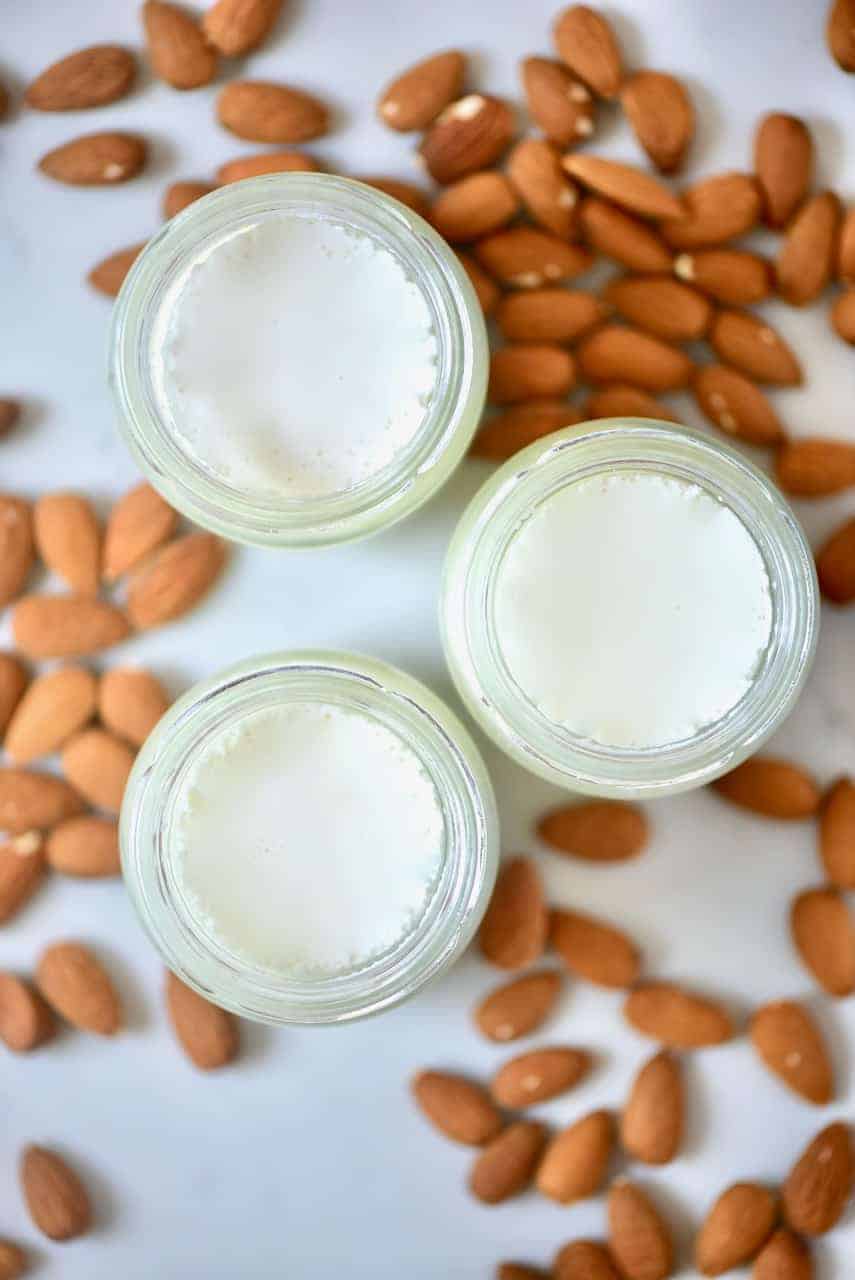
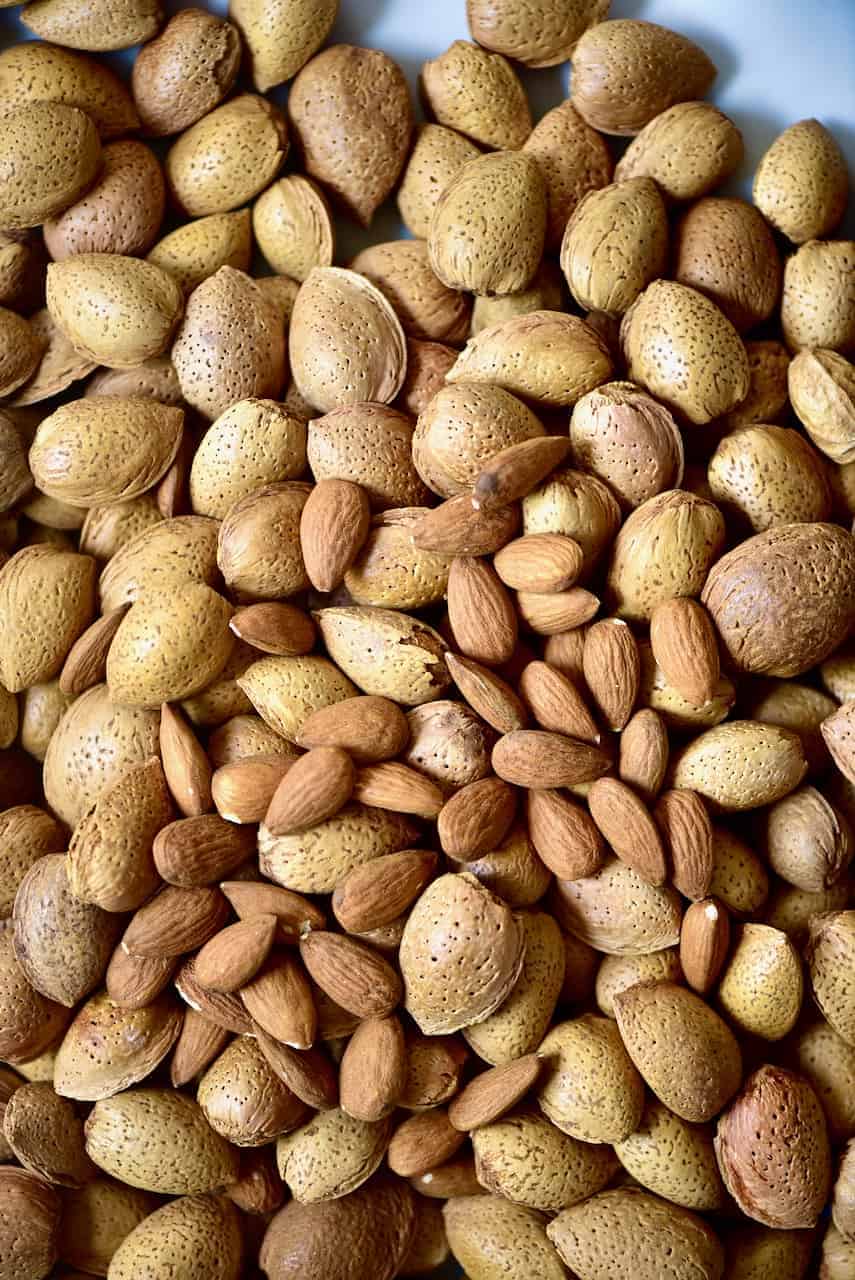
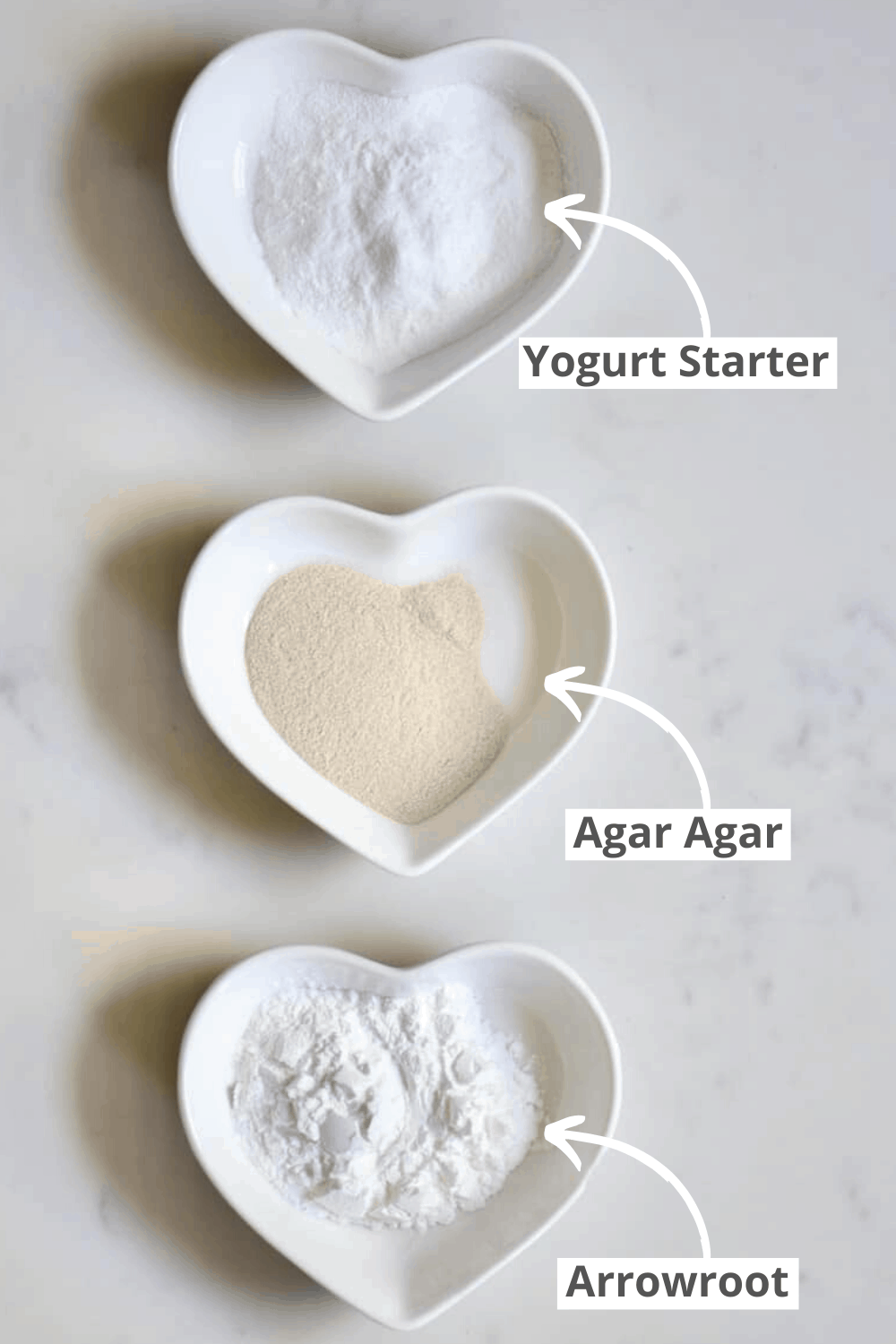
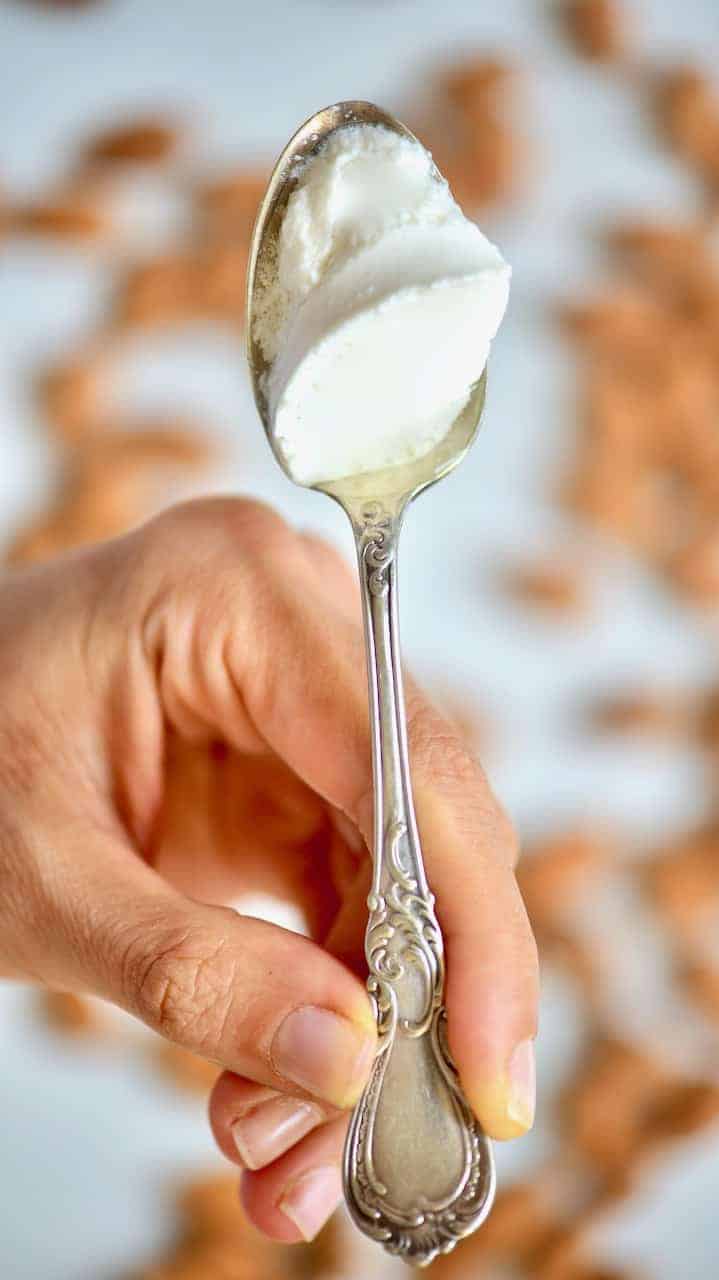
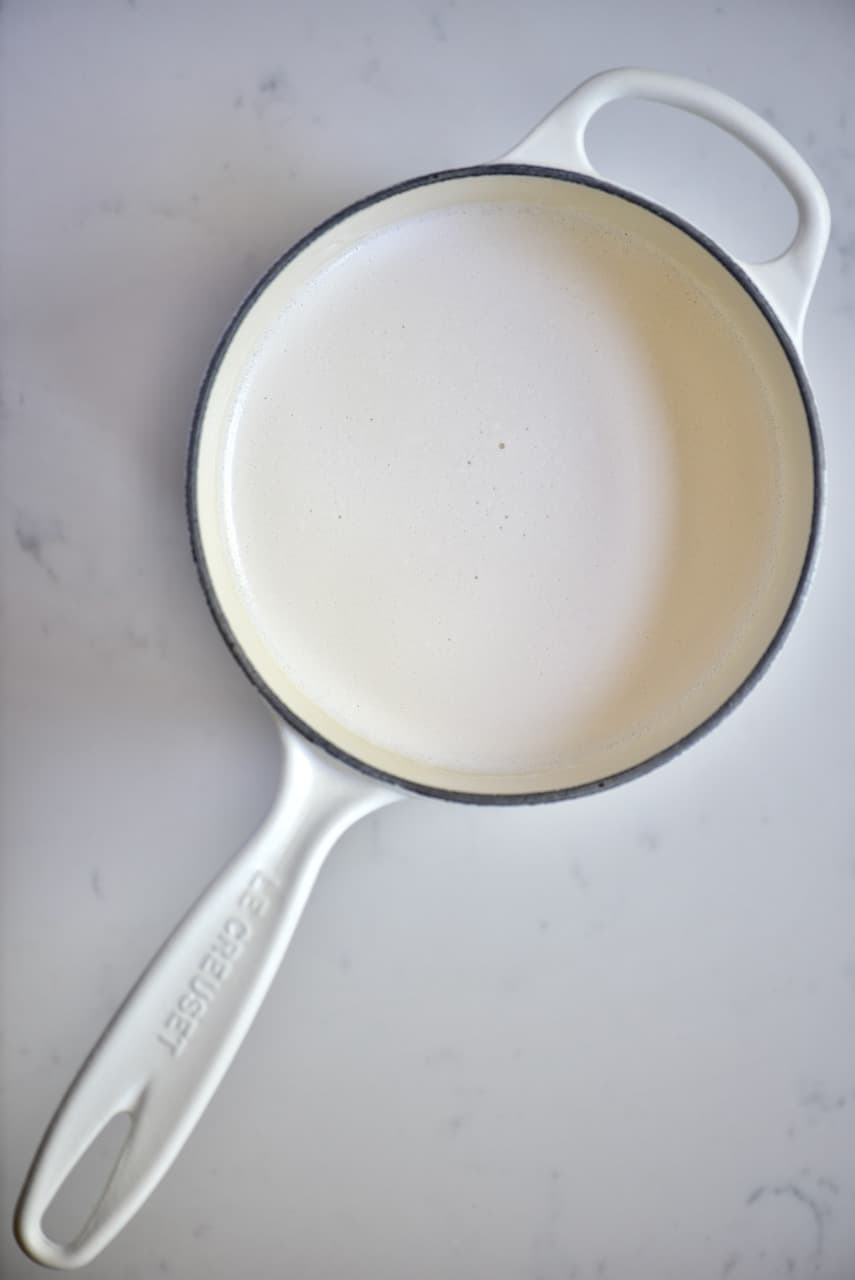
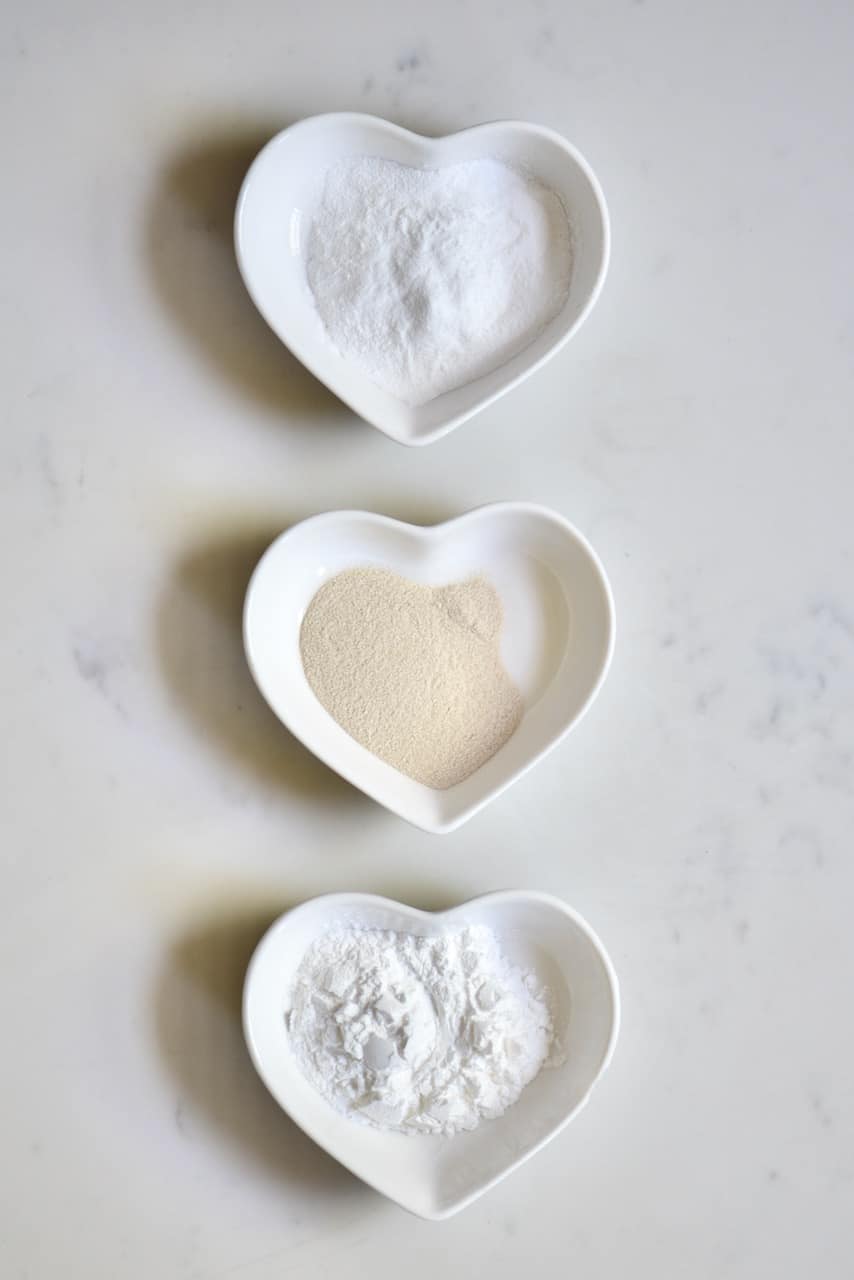

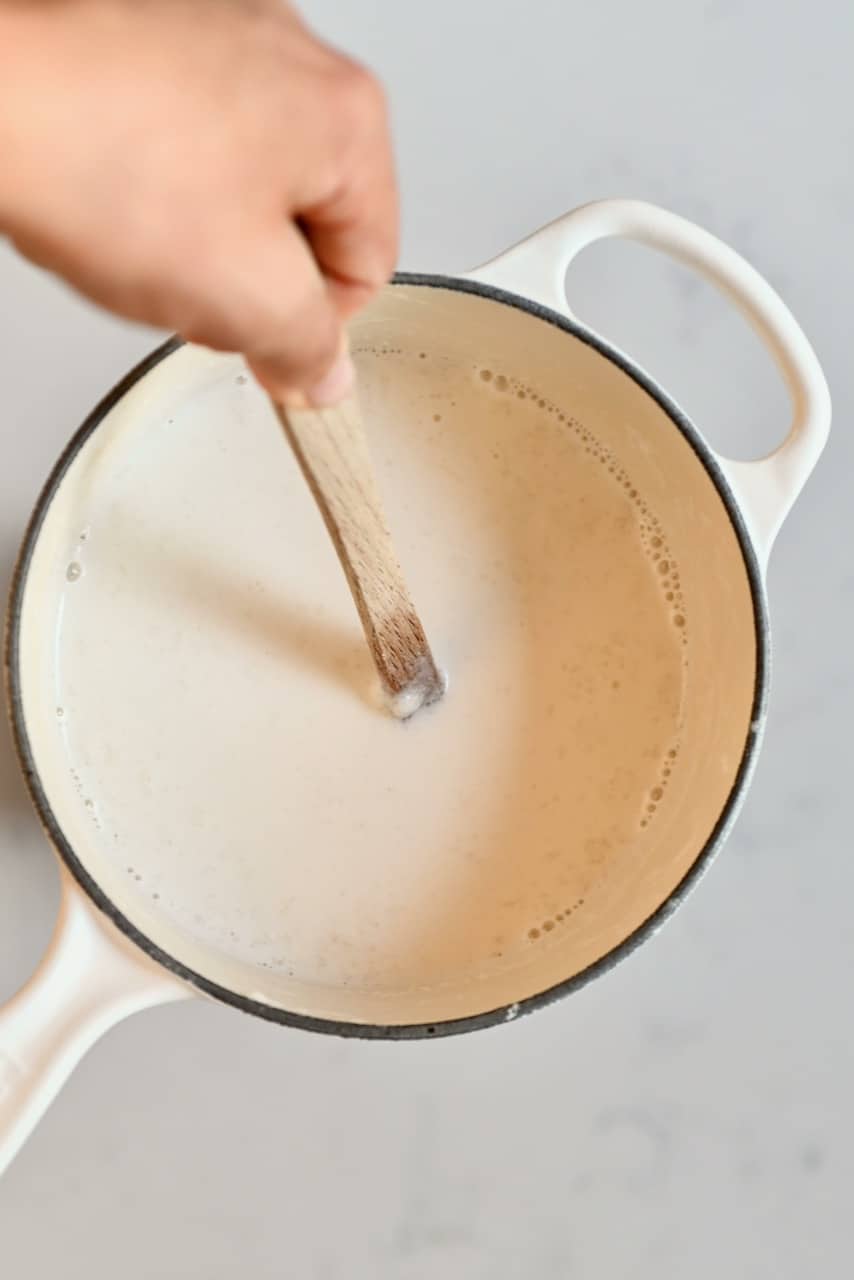
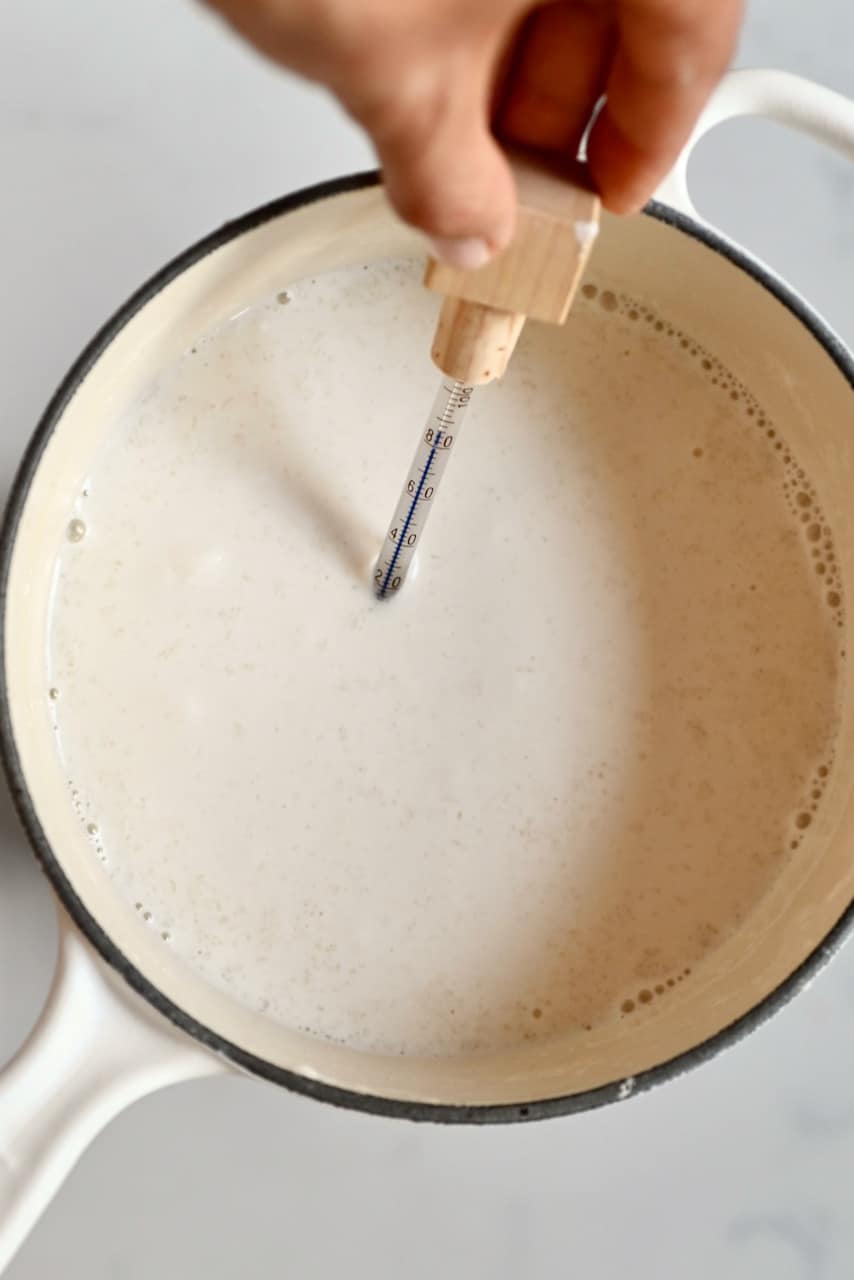
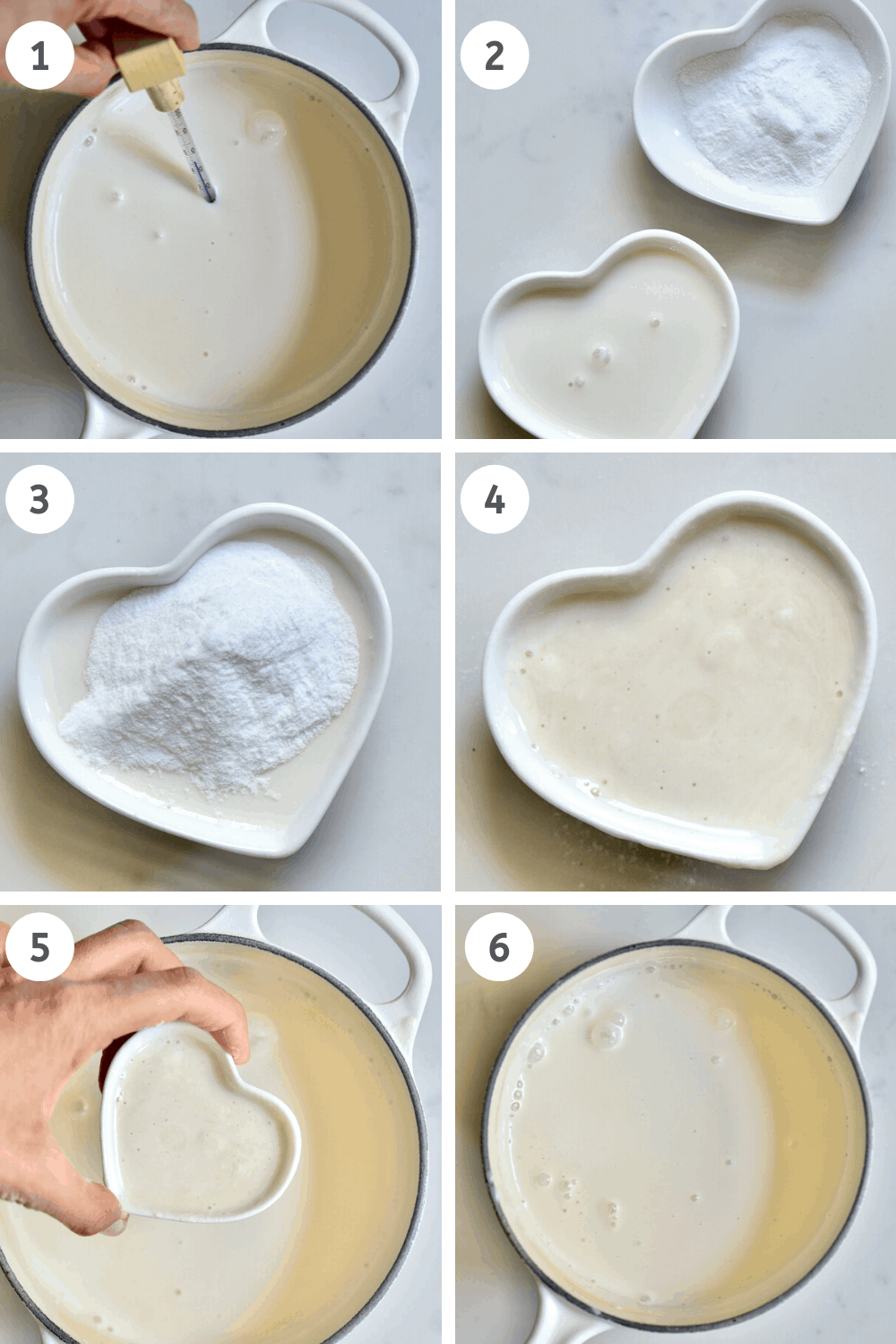
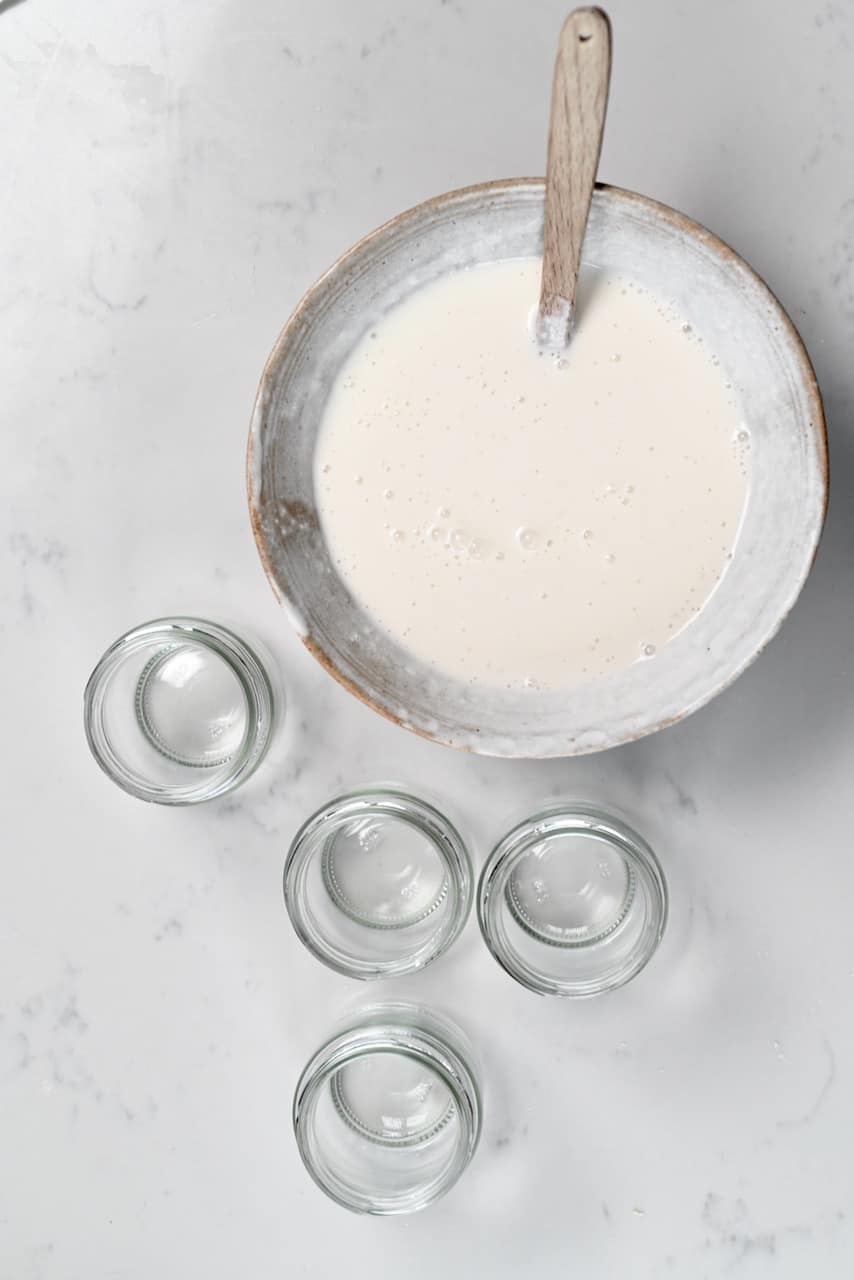
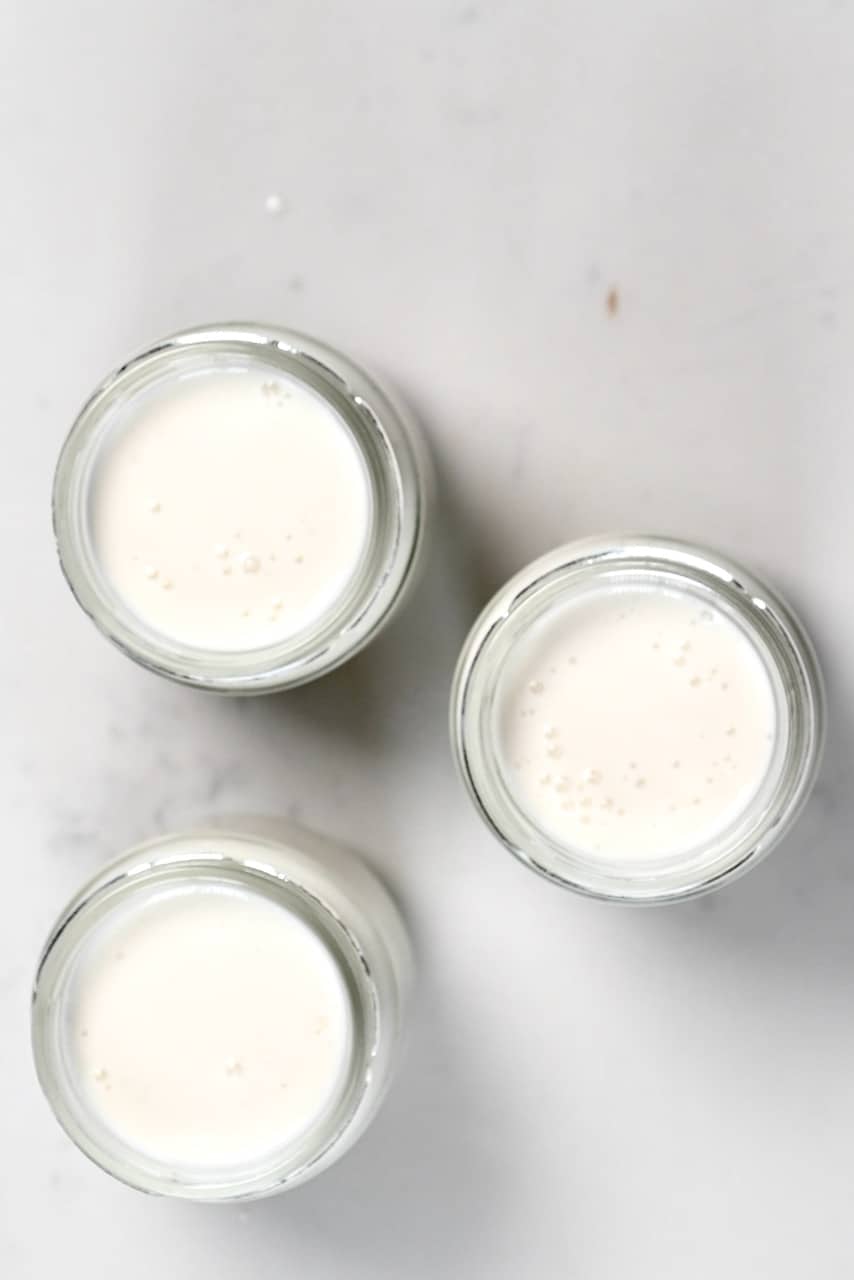
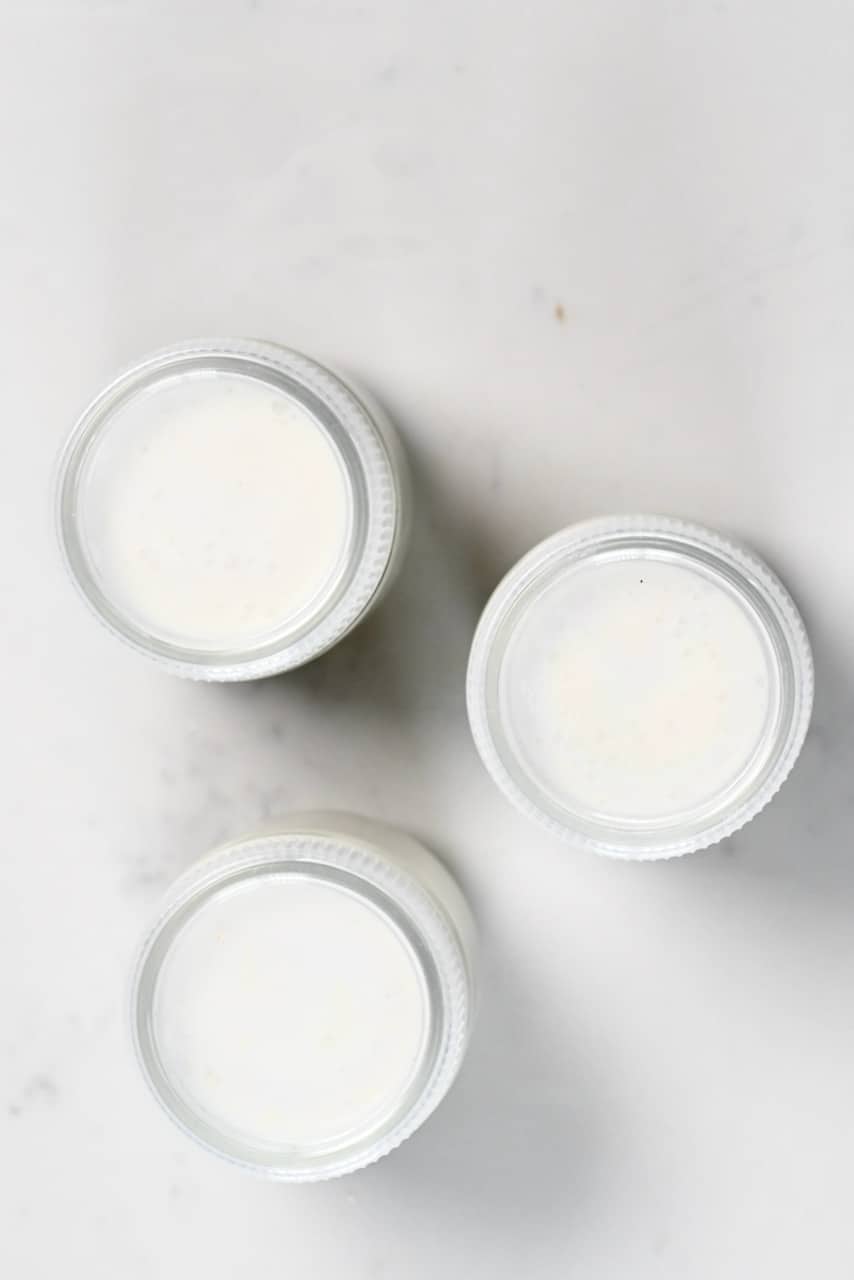
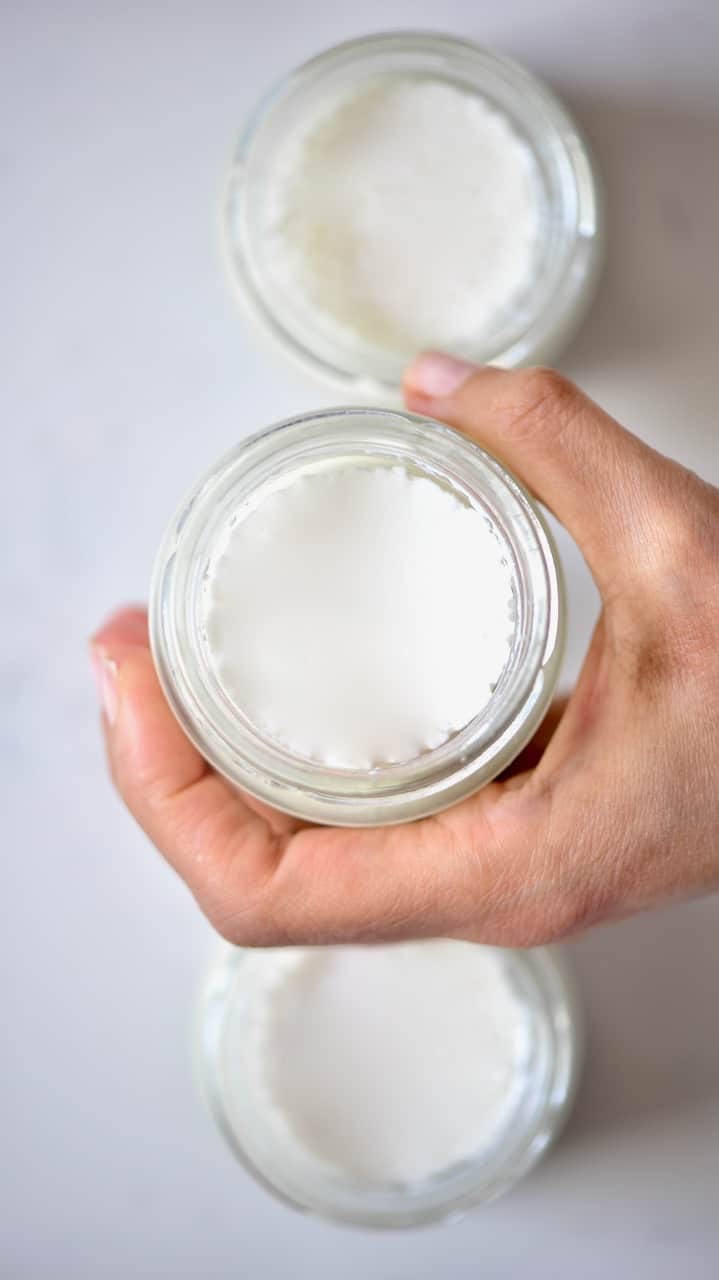












What can I use instead of a yoghurt starter?
Hi,
I recommend using a powdered yogurt starter for the best results. Alternatively, you can try with probiotic capsules. Please note that the powdered starter has 2 Billion live cultures per pack. Make sure to use enough capsules and to open them and use only the powder inside.
Do I need a thickener to make almond yogurt with homemade almond milk?
Hi Catherine,
Yes, you still need a thickener because plant-based yogurt alternatives don’t thicken up enough on their own with just the yogurt starter, unlike dairy-based products.
Hey! Your blog is awesome, been stuck here for about 3 hours now!!
I’m wondering if you can use the yoghurt that you get from this recipe as a starter for the next batch? That’s what I normally do with dairy yoghurt. But I’ve starter Veganuary and looking for vegan options as they are either hard to find or super expensive where I live 🙁
Haha, I’m glad you’re enjoying it. Yes, you can use some as the starter for the next batch. I usually start from scratch after 3-4 batches or when I notice that it’s becoming weaker 🙂
Hi Samira,
I am looking into making Almond Yogurt for the first time, and I do have yogurt starter, but I am interested in using some of the yogurt I make to start a new batch when I make it the second, third time, as you mentioned it is possible to do this, but my question is, how many grams of the yogurt should I use instead of the 5 grams of starter?
Thank you.
Hi Christiane,
You can use 1-2 Tbsp of the yogurt to start a new batch. Just remember that the starter will get weaker if you keep on using it for your next batches. I would recommend starting from scratch again after a few new batches.
Hi I wanted to try making your yogurt recipe. I have probiotic capsules that are 5 billion. How many capsules would you suggest? Alternatively, can I use an organic almond milk yogurt as a starter? if so how much? thanks for your help.
Hi Mary Anne,
The starter I use has 2 Billion live cultures per pack so it sounds like 1 capsule of your probiotic should be enough. Make sure you open it and use only the powder inside. Also, just to share my experience, I’ve used probiotic capsules instead of a starter but they don’t always yield great results (as they have various ingredients); that’s why I prefer to use the specialized starter pack. I hope you get better results than me.
Regarding the milk – if you use store-bought milk, it would be best to look for a “cleaner” version – with none or very few additives/preservatives. Organic would be a plus but the milk could still have a lot of additives and these additives could affect the yogurt-making process. That’s why I recommend making the milk at home. If you go with a store-bought one, you need 4 cups of milk.
I hope this helps.
My Yogurt keeps turning out grainy, like grits. Any idea what I’m doing wrong?
Hi Nate,
There might be different reasons for this: did you heat the milk too fast? Did you overheat the milk? Do you think your starter was active (fresh and not very old?). When you stirred the starter did you distribute it thoroughly throughout the mixture?
I’m pretty sure its me, but the yogurt keeps ending up grainy. What am I doing wrong?
Hi Nate,
It’s possible that you heat up the milk too quickly – that’s when it usually turns grainy. I recommend using low-medium heat and slowly bringing up the temperature of the milk.
Also, I find that agar-agar helps with the texture, making it smoother.
I hope this helps.
Hi! I d live to make almond yogurt and I have all the ingredients except yogurt starter. What I have instead is pro biotic capsules. Dobrou know if it s ok? Thank you so much!
Hi Flora,
I’ve used probiotic capsules instead of a starter but they don’t always yield great results. If you try with the capsules, make sure that they have a very high count of live cultures. For example, the starter I use most often has 2 Billion live cultures per pack. I hope this helps.
Hi there,
I already made my weekly homemade almond milk 2 days ago. How many cups of that will I need for this recipe?
Many tx!
Hi Mishal,
You can use 4 cups of almond milk for this recipe, I hope this helps.
I just did this recipe using hazelnut milk and it was delicious!!!!!
So glad to hear Luiza, thanks so much for letting me know :-).
would it work with agar agar & corn starch ? (I don’t habe the others), also – if I use store bought milk – it should be fine ?
Hi Rachel,
I haven’t trie with agar agar and corn starch but it should work. You need to add them when heating the milk.
As for store-bought milk – look for one that doesn’t have any additives as they can prevent the process for working properly. And I would recommend using a milk with a high % of almonds (very often the almonds are under 10% and the rest is moslty just water). I hope this helps.
Hello. I love your almond yogurt recipe. However, I couldn’t figure out what the starter is?
Thank you,
Frugh
Hi, I contain a link to the yogurt starter that I used, within the post. It’s called ‘non-dairy yogurt starter’. Hope that helps 🙂
Is there a way to do the process with an instapot? I’m still learning so unsure of settings
Hi Shawna,
A lot of instant pot brands have a specific yogurt setting so that you can make yogurt with them. It would be best to check the instruction manual for your machine to know which setting to use.
I hope this helps.